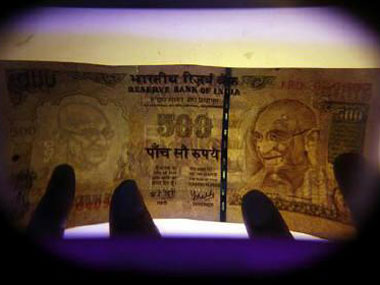By George Albert
The rupee has begun its downtrend again after appreciating for a few weeks and is expected to be range-bound for some time. The dollar-rupee pair is establishing a new playing range between 48.65 and 53.75, which can prove to be fertile trading zone.
[caption id=“attachment_239757” align=“alignleft” width=“380” caption=“The rupee downtrend is expected to remain range-bound against the dollar and euro for some time. Reuters”]  [/caption]
The euro-rupee pair is also exhibiting price action similar to the dollar-rupee pair. After falling to a support level of 64 the pair is now rallying to potentially form a trading range of 64 to 71. In our article published on 11 February 2012, we had warned that the rupee’s rally against the dollar and euro may stall and reverse and that’s exactly what’s happened.
The dollar-rupee pair had a rapid drop after a fast rally which took it all the way to 53.75. The quick depreciation of the rupee from 48 was not sustainable as lightening fast moves are generally retraced before the trend resumes again. A rapid rise in prices is, of course, the result of buyers exceeding sellers. Since current buyers are future sellers, the prices fall rapidly once the asset class begins to reverse.
In the case of the dollar-rupee pair, it had shot out of the 48.65-50 range after trading in that zone for a long time. Since that was the point of the rally, once prices returned to it, the likelihood of a rally again was high. Over the past few days, the prices entered the zone, stayed in it and then broke above 50 on 5 March to touch 50.37.
Given the breakout we may see prices head towards 53 once again. However, if prices close below 48, the pair can continue to fall, which essentially means that the rupee will appreciate.
Euro-rupee: Unlike the dollar-rupee pair, the rise in the euro-rupee was slow. However, the drop since the beginning of 2012 has been rapid, which makes a quick rise possible. Prices fall when the number of sellers far exceeds the number of buyers. But current sellers are potential buyers and prices tend to rise quickly when a downtrend is reversed. The fall in the euro-rupee pair since the beginning of 2012 was arrested when prices hit 64. Then prices moved in a range of 64-66 before breaking out of it on 5 March to go all the way up to 66.41 before falling rapidly to 65.50 last Friday.
If the pair does not close below 64, the uptrend is intact and prices can go all the way up to 69.
If one wants to bet against the rupee, the dollar-rupee is a better pair that euro-rupee since the dollar has been showing relative strength against other currencies in the international markets. Fundamentally, too, the dollar is better placed than the euro as the US is seeing economic growth while the eurozone faces the prospect of a recession.
Gold bullish, but doubts emerge: The uptrend is gold is still intact but there are some clouds on the horizon. For the first time since since 2008, gold has breached the 200-day simple moving average.
The black line shows the 200-day moving average. A moving average is the average of closing prices over a specified period of time. The blue arrows show prices breaching the average twice the latest being last week.
Since the average is still sloping up, long-term players stay bullish. But the more times prices penetrate the average, the greater are the chances that it will fall below and the average slope down or go flat. Hence, this calls for caution on the part of dollar bulls.
In 2008, even when prices were below the 200-day average, gold moved sideways and eventually rallied. Given the fact that the US Fed has pumped a lot of dollars that can lead to inflation once the economy picks up, long term investors may still stay long on gold with a tight stop-loss.
George Albert is Editor, www.capturetrends.com


)
)
)
)
)
)
)
)
)



